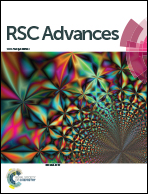A uracil nitroso amine based colorimetric sensor for the detection of Cu2+ ions from aqueous environment and its practical applications†
Abstract
A simple uracil nitroso amine based colorimetric chemosensor (UNA-1) has been synthesized and screened for its cation recognition ability. Sensor UNA-1 exhibited a high sensitivity and selectivity towards Cu2+ ions in aqueous medium in the presence of a wide range of other competing cations (Ag+, Al3+, Ba2+, Ca2+, Cd2+, Co2+, Cr3+, Cs+, Fe2+, Fe3+, Li+, Mg2+, Mn2+, Na+, Ni2+, Pb2+, Zn2+, Hg2+ and Sr2+). With Cu2+, the sensor UNA-1 gave a distinct color change from colorless to dark yellow by forming a complex of 1 : 1 stoichiometry. Furthermore, sensor UNA-1 was successfully utilized in the preparation of test strips and supported silica for the detection of Cu2+ ions from aqueous environment.



 Please wait while we load your content...
Please wait while we load your content...